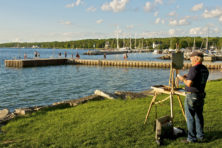Jim Seaquist and the Changing Landscape of Orchard Management
- Share
- Tweet
- Pin
- Share
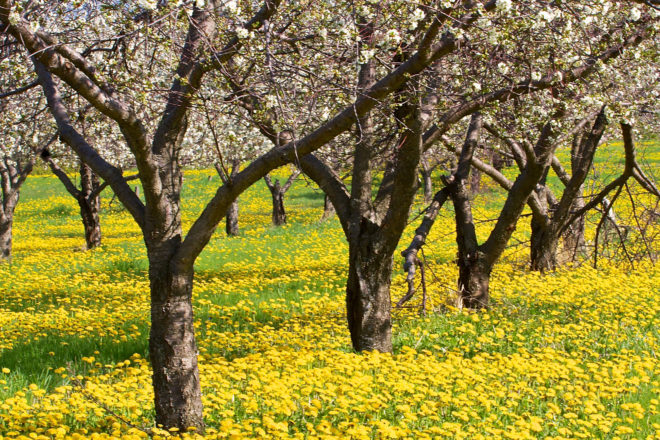
For years, the ways in which crops were managed followed a largely rote pattern of pesticide application (a term that includes disease, insect and weed control). This began to change in 1962 when Rachel Carson published her groundbreaking book Silent Spring. Carson noted the detrimental affects to the environment caused by many of the most common pesticides, particularly DDT. And while Carson’s book caused a public and academic uproar, it took an additional 10 years before the Environmental Protection Agency began to phase out DDT as a pesticide.
Since that time the scrutiny and research of pesticides has grown almost exponentially. And the ongoing evolution of technology has fundamentally changed not just how pesticides themselves are scrutinized, it has also changed the manner in which pesticides are used in our orchards.
Jim Seaquist, a partner at Seaquist Orchards (Wisconsin’s largest cherry-producing operation), puts it this way:
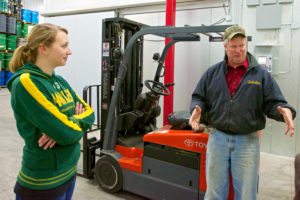
Jim Seaquist at the processing facility. Photo by Len Villano.
“Back in the 1960s growers were using recommended best practices for their crops. They weren’t intentionally doing anything to harm the environment. But there is no doubt that those practices led to arsenic and lead contamination in our soils and water, particularly in the areas [within the orchards] where these pesticides were being mixed and loaded into sprayers.
“All growers want to do what is right,” he continued, “and we believe that today our practices are safe.” He goes on to point out that his own home, and the homes of many of his extended family and employees, are situated in or abutting orchards.
Seaquist notes that today pesticides and the resulting residuals receive a whole different level of scrutiny than 50 to 60 years ago. And this scrutiny has led to significant changes in the way orchards are managed.
An ongoing consideration in any agricultural operation is fertilization. Plants use nutrients from the soil in order to grow and, in the case of orchards, to produce fruit, and these nutrients need to be replaced.
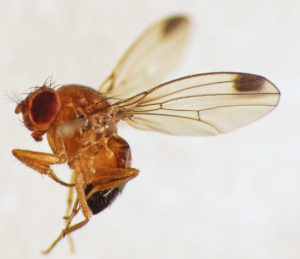
A male Spotted-wing Drosophila, an Asian invasive that first appeared in the U.S. in 2008. Photo by Martin Cooper.
“With the surveying technology available today,” Seaquist explained, “we can map our orchards so we know where the most sensitive areas are located [i.e. those with the least topsoil] and with this information we can adjust how we treat the soil. So sensitive areas will receive a lighter treatment more frequently.”
This allows the trees to absorb the nutrients they need without excess washing through the soil.
Seaquist Orchards has also been working closely with the Peninsular Agricultural Research Station using mulch (primarily tree and bark) to maintain moisture and nutrients in the soil while reducing weed encroachment. This is an ongoing project that shows considerable promise on the peninsula.
One of the most significant changes is in the way orchard owners manage insects. Today, again thanks to technology, insecticides are highly targeted and are managed with both environmental and economic considerations in mind.
“We have a great understanding of the lifecycles of the insects that affect our fruit trees today,” Seaquist said. “By understanding these lifecycles we have a better understanding of when it is necessary, and when it is not necessary, to treat for insects. We approach it from the standpoint of doing as little as possible – even if the products we are using are safe.”
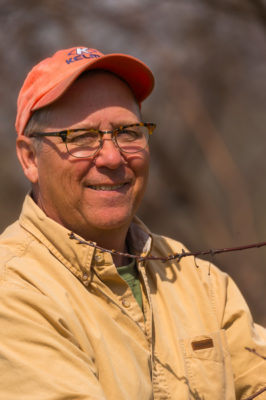
Matt Stasiak of the Peninsular Agricultural Research Station. Photo by Len Villano.
“The traditional insect threats to cherries and apples are the plum curculio, a type of weevil that appears shortly after the trees bloom,” explained Matt Stasiak, superintendent of the Peninsular Agricultural Research Station, “and the cherry fruit fly, which appears about three weeks before harvest time and targets bruised or damaged fruit.”
Seaquist, a graduate of Michigan State University, maintains close contact with his alma mater, one of the leading cherry growing research institutions in the country, working toward a goal of reducing insecticide application processes as much as possible.
Helping make this goal possible are five sophisticated weather stations situated at key locations throughout the county. With the help of these stations, growers are able to track the arrival of pests by following the number of “degree days” in the growing season.
“Basically we are tracking heat accumulation when we talk aboutdegree days,” explained Stasiak. “More heat [more degree days] means the fruit grows faster.
 “Additionally, tracking the heat accumulation helps us calculate when a pest is likely to emerge,” he continues, “which helps us determine when growers need to begin treatment.”
“Additionally, tracking the heat accumulation helps us calculate when a pest is likely to emerge,” he continues, “which helps us determine when growers need to begin treatment.”
Cherry and apple growers don’t rely solely on technology, however. During the growing season orchards are inspected on an almost daily basis.
“We have a man from Southern Door who is in our orchards at least three days a week [during the growing season] inspecting the trees and scouting for signs of insects,” Seaquist said. “I probably talk with him, personally, four to five times a week.”
Today, traditional threats like spotted leaf disease and the two main insect threats are very well understood.
“The third insect threat is an invasive called spotted wing drosophila, which came from Asia and appeared on the West Coast in 2008-2009,” Stasiak continued. “The drosophila is able to cut into healthy fruit and appears about four weeks before harvest. They go through about six to eight to ten generations in a year [considerably more than the weevil or cherry fruit fly], meaning that they grow to a very large population in a very short time. They also have a virtually unlimited number of alternate hosts [beyond cherries and apples] where they can lay their eggs. So they are a real challenge and the focus of extensive research across the country.”
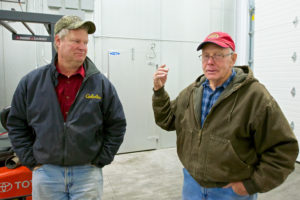
Jim Seaquist (left) and his father Dale. Photo by Len Villano
Currently, the drosophila is managed by the same treatments growers use to manage the cherry fruit fly and the plum curculio: insecticides like Actara, Imidan, and/or Delegate.
These insecticides affect the insect’s nervous system but unlike similar treatments from years ago, these newer treatments have a significantly higher parts per million tolerance and, most importantly, break down much more quickly in the environment when they are applied following EPA guidelines, according to Stasiak.
The ongoing challenge for fruit growers is finding the balance that will keep the orchards profitable while maintaining a healthy environment in both the near and long term.
“My family views ourselves as stewards of the land we grow on. We have about 30 land agreements with property owners where we grow fruit, in addition to our own orchards, and we take the responsibility of caring for all these lands very seriously,” Seaquist said. “This is a big load to carry and we have a major vested interest in not screwing this up.
“I feel better about what we are doing today to maintain and grow our fruit than I have felt at any other time.”

